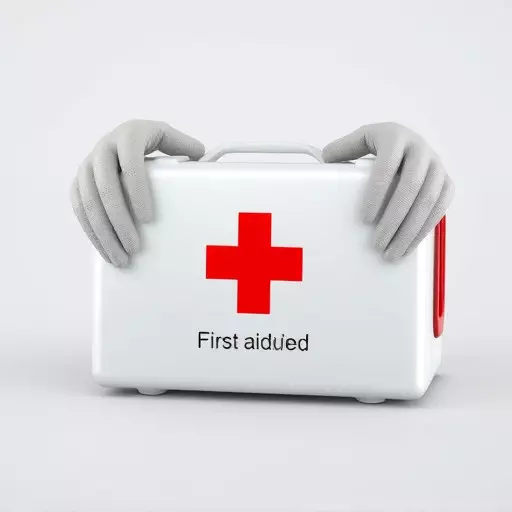Seizures, a medical emergency with various types and triggers, demand understanding and swift action. First aid and CPR training, including Basic Life Support (BLS) certification, equips individuals to recognize seizure activity, differentiate it from other conditions, and provide appropriate first aid until professional help arrives. Key steps include removing hazards, positioning the individual in the recovery position, delivering rescue breaths if trained, and staying with them until consciousness returns, aligning with BLS certification requirements. Comprehensive first aid training is crucial for responding effectively to seizures, minimizing risks, and enhancing overall well-being.
Seizures can be frightening, but understanding them and knowing how to provide first aid can make all the difference. This comprehensive guide explores various aspects of managing seizures, from recognizing different types and their causes to performing essential first-aid techniques. Learn about critical interventions during a seizure emergency, including CPR and basic life support (BLS) skills, and discover the importance of obtaining first aid and BLS training to meet the unpredictable nature of these events.
- Understanding Seizures: Types and Causes
- Recognizing the Signs: When to Intervene
- Basic First Aid for Seizures: Steps to Take
- CPR and Basic Life Support: Importance in Seizure Emergencies
- First Aid Certification Requirements: Preparing for an Unpredictable Event
Understanding Seizures: Types and Causes
Seizures are a common medical emergency that can occur due to various reasons. Understanding different types and causes is essential for anyone with first aid and CPR training, as it enables them to respond appropriately during such incidents. There are two primary categories: generalized seizures, which involve the entire brain, often characterized by sudden loss of consciousness and convulsions; and partial or focal seizures, affecting only a specific part of the brain, leading to localized symptoms like arm or leg movements, facial twitches, or sensory changes.
Several factors can trigger seizures, including genetic predisposition, head injuries, stroke, tumors, brain infections, high fever, certain medications, excessive alcohol consumption, and sleep deprivation. Individuals with no known underlying conditions may experience what are called ‘idiopathic’ seizures, which require medical investigation to identify the cause. Basic Life Support training equips individuals with the skills to recognize seizure activity and differentiate it from other conditions, thus ensuring prompt and appropriate first aid is administered until professional help arrives.
Recognizing the Signs: When to Intervene
Recognizing the signs of a seizure is crucial for anyone with basic life support training and first aid certification. Seizures can manifest in various ways, from subtle changes in behavior to full-on convulsions. Common indicators include sudden and unexpected jerks or twitches of the muscles, brief loss of consciousness, or repetitive movements like chewing or stammering. If you witness someone experiencing these symptoms, it’s essential to intervene promptly.
First aid and CPR training equip individuals with vital skills to handle such emergencies effectively. When intervention is necessary, keep yourself calm and assure the person having the seizure that help is on its way. Move any sharp objects away from them and place them in a safe, clear area. Time the duration of the seizure if possible, as this information can be critical for medical professionals later. After the seizure ends, help the individual to a safe, comfortable position and remain with them until they regain consciousness fully. Remember, understanding first aid certification requirements and staying calm during such incidents can make a significant difference in managing seizures effectively.
Basic First Aid for Seizures: Steps to Take
When someone experiences a seizure, it’s crucial to act swiftly with appropriate first aid and CPR training. The goal is to ensure safety and minimize potential risks during and after the episode. Here are essential steps to follow:
1. Protect and Prepare: During a seizure, the individual may lose consciousness or control of their body. Remove any sharp objects or hazards from their vicinity to prevent injuries. Place them on their side in the recovery position, which helps maintain an open airway and reduces the risk of choking. If you’re trained in basic life support (BLS), be prepared to deliver rescue breaths if necessary. Always stay with the person until the seizure fully subsides and they regain consciousness.
CPR and Basic Life Support: Importance in Seizure Emergencies
In a seizure emergency, effective first aid can make all the difference in ensuring the best possible outcome for the affected individual. One of the cornerstones of such aid is CPR (Cardiopulmonary Resuscitation) and Basic Life Support (BLS). These life-saving techniques are crucial, as seizures can disrupt normal breathing patterns, potentially leading to suffocation if left unaddressed.
CPR and BLS training equips individuals with the knowledge and skills to recognize when intervention is required and how to administer rescue breaths and chest compressions effectively. First aid certification requirements often include these courses, emphasizing their importance in managing seizure emergencies, as well as other critical situations where immediate action can prevent severe health consequences or even death.
First Aid Certification Requirements: Preparing for an Unpredictable Event
Having a solid understanding of first aid and CPR training is crucial when it comes to responding to unpredictable events like seizures. While anyone can encounter someone having a seizure, only those with proper first aid and CPR training are equipped to handle such situations effectively. Basic Life Support (BLS) training is a foundational step, providing individuals with the skills to recognize and respond appropriately to life-threatening conditions, including seizures.
To ensure preparedness, aspiring first aiders should focus on completing comprehensive first aid certification requirements. These programs typically cover various topics relevant to seizure management, such as assessing the scene, protecting both the patient and bystanders, and administering appropriate interventions until professional medical help arrives. Staying updated with recent guidelines and practicing skills through mock scenarios can further enhance one’s ability to respond calmly and confidently in real-life situations.


